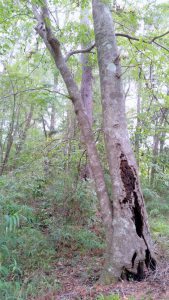
Beech, magnolia and native
river cane (arundinaria) characterize hardwood forests in the Red Hills
Photo by Jed Dillard
I grew up in the Georgia Piedmont outside Athens, a land of bright red sticky clay, rocks and cold weather. In addition to the ubiquitous Georgia pines, hardwoods including white oaks, hickory and beech grow there. I had no clue the Red Hills of Florida and South Georgia would mimic much of that habitat and provide the benefits of fewer rocks to blunt shovels and less cold weather. Now, I can hardly imagine living anywhere else than in one of its beech – magnolia forests.
A friend of mine was doing some work for my neighbor and took the time to look for wild turkey roosting places and walked down to the creek bed through beech, magnolia, spruce pine, white oak and hickory to where the wild azalea grows. “Those sure are some pretty woods, “he told me.
He was describing the upland hardwood forest described by the Florida Natural Areas Inventory as “a well-developed, closed-canopy forest dominated by deciduous hardwood trees on mesic soils in areas sheltered from fire. It typically has a diverse assemblage of deciduous and evergreen tree species in the canopy and midstory, shade-tolerant shrubs, and a sparse groundcover. “ Blaisdell, et al characterized their location as areas “too steep for logging, farming, or grazing and are mesic (wet) enough so that fire rarely occurs in them. “
Many of these areas are relatively small and have escaped intervention. These small areas contribute to patchwork landscapes which provide the key requirements of wildlife habitat- shelter, food and water. Turkeys roost in the spruce pine over the creek and the hens build nests and forage with their poults on the seeds and bugs of the adjacent open fields. I had always thought of Florida as a sandy coastal environment, but these hills have more clay than most Florida sites underneath them. The combination the canopy’s protection of the moisture in layers of organic matter and the soil’s clay maintain a fertile, well-drained soil profile which supports a wide variety of plants and a varied supply of mast.
Of all its flora and fauna, one of its most intriguing species is the Barred Owl, Strix varia. Judy Biss of Calhoun county’s December 4, 2015 Panhandle Outdoors Article, Owls, Florida’s Remarkable Nocturnal Birds of Prey describes the natural history and biology of owls in Florida. The first time I heard a nearby Barred owl, I thought I was in presence of a fierce beast, surely a panther, at least a bob cat. The Tarzan movies filmed at Wakulla Springs used the Barred Owl calls for jungle sounds. Barred owls thrive in this habitat. The open forest floor and mature trees give them room to navigate and an abundant variety of prey. Snags and trees whose limbs are broken off by wind, provide cavities for them and other cavity nesters.
Pretty woods? Upland Hardwood Forests? Climax Beech Magnolia Forests? No matter what you call them, they’re one of the jewels of North Florida’s range of habitats. Get out and enjoy them.
References and additional information.
http://www.sfrc.ufl.edu/extension/4h/ecosystems/upland_hardwoods/upland_hardwoods_description.pdf
“The Role of Magnolia and Beech in Forest Processes in the Tallahassee, Florida, Thomasville, Georgia Area”. Blaisdell, Wooten and Godfrey. Tall Timbers Research Station
http://fnai.org/PDF/NC/Upland_Hardwood_Forest_Final_2010.pdf
